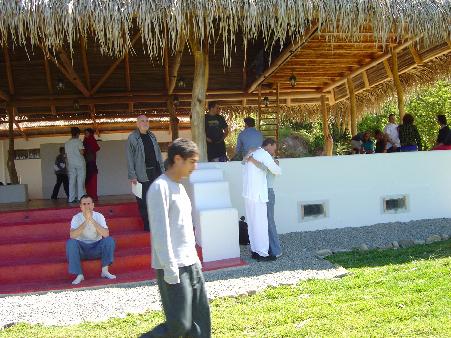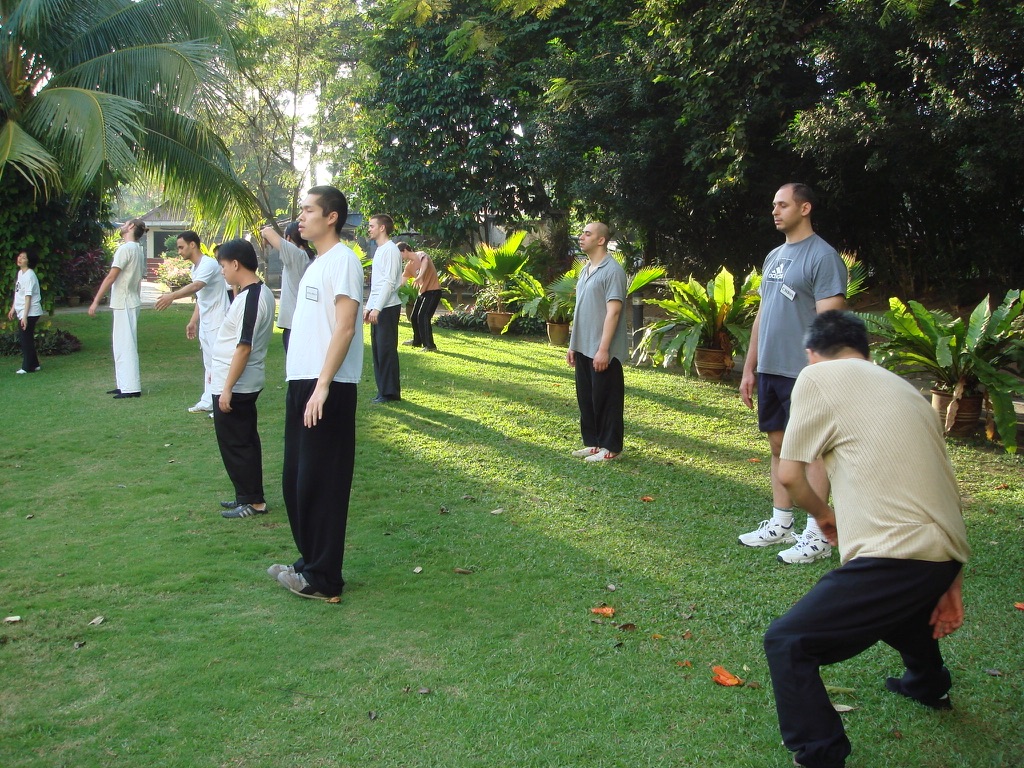QUESTIONS ON SPIRITUALITY AND OVER-TRAINING

Spiritual cultivation is an important aspect of our training in Shaolin Wahnam. In an exceptionally brilliant class in Costa Rica in 2004, many participants attained a satori, or spiritual awakening. This photograph captured the immense emotion then. In the foreground a student knelt down in deep gratitude, behind him another student was still sitting in disbelief, while Rama, the Resident Master of the centre, hugged his wife crying tears of joy!
Spirituality
Sifu, I hope I can trouble you with these additional questions, if you are not too busy.
How spiritual were the masters of old, if they were not practicing for the purposes of spiritual cultivation? For instance, Hong Xiguan and his comrades were intent on killing Manchus, and masters in the Yang family had to fight daily to keep their position in the Imperial household. From what I observe at Sifu's courses, many of Sifu's students attain far higher enlightenment than some classical kungfu masters.
Zhang Wuji
Sifu's CommentsWe have been talking about the greatest martial arts at their highest levels. Much of Taijiquan and Shaolinquan practiced today are not even mediocre martial arts, they are graceful health exercise or brutal sport. Even in the past, when Taijiquan and Shaolinquan were usually practiced as martial arts, they were, however, not practiced at their highest levels. Many Taijiquan and Shaolinquan masters in the past were good fighters, but not spiritual cultivators; some were even brutal.
Hong Xiguan and his comrades lived in a society very different in mental make-up and environment from us. Their aim was to overthrow the Manchurian Dynasty and restore the Ming. Given this situation, Hong Xiguan was compassionate. He did not purposely sought out the Manchus to kill them. In fact, he was on the receiving end, he had to escape the Manchurian Army so as not to be killed.
We may sound presumptuous, but I believe many of us in Shaolin Wahnam have attained a higher spiritual level higher than many kungfu masters in the past. Most of us are cheerful, open and happy, whereas most kungfu masters were stoic, closed and suspicious, some were even hateful and aggressive. Most of us understand the spiritual dimension and some of use have had satoris or spiritual awakenings. Most kungfu masters in the past, even amongst internal art masters, were ignorant of the spiritual dimension, and attaining a sattori by a kungfu master was a rarity.
Wong Kiew KitOver-Training
How did masters of old avoid over-training? I believe they practiced something like 2 to 4 hours a day.
Zhang Wuji
Sifu's CommentsThey avoided over-training the same way we do. They followed carefully the principle of gradual progress. When warning signs appeared they slowed down or stop training, when they injured themselves they took herbal medicine or chi kung therapy, when they were tired from training they rested.
Training for two to four hours a day would be among the minimum. Most masters trained for six to ten hours a day. Stance training itself would have taken an hour or two.
But the quality of training was different. Other people may think us vain or egoistic, but I honestly believe that the cost-effectiveness of even past kungfu masters might be lower than ours today. Our students could have chi flow and experience internal force within a month, but past practitioners would need a few years. Most participants to my intensive courses had chi flow and felt internal force on their first day!
Even at the Shaolin Temple in the past, there was much hard and rough training, what we now endearingly call “water-buffalo methods”. They practiced stance training for hours, but I suspect that apart from the exceptional masters, most of them tensed their muscles to endure the stance. They hit sand bags and kicked at poles. They carried weights and jogged. Chi kung exercises like what we do were reserved for special disciples. I believe that we now can achieve in an hour what they would need six hours.
But despite their inferior methods, I believe their standard of kungfu was much, much higher than ours. This was another reason why they could, or had to, train for long hours.
Wong Kiew Kit
 Most students to Sifu Wong's Intensive Courses in Malaysia, like the ones shown in the photograph above, experienced chi flow and internal force on the very first day!
Most students to Sifu Wong's Intensive Courses in Malaysia, like the ones shown in the photograph above, experienced chi flow and internal force on the very first day!
- The Evolution of Taijiquan from Shaolinquan
- General Practice and Training, and Sparring Methodology
- Combat Philosophy on Retreat and Yielding
- Difference in Stances
- The Use of Internal Force
- Fa-jing and Qin-na
- Academic Questions and Direct Experiences
- Yin-Yang, God and Health
- Spirituality and Over-Training
- Questions on Sinew Metamorphosis
- Questions on Breathing Methods and Control
- Taoist Philosophy and Concept of Open and Close
LINKS
